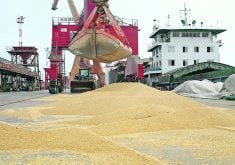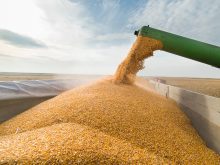It’s official. The year 2008 is now the Year of Volatility.
Last week, the Financial Times reported that commodity prices in July had their greatest monthly drop in 28 years, thanks largely to declining oil and corn prices.
Last month, the Reuters Jeffries CRB index, a measure of world commodity prices, sank 10 percent, the largest monthly drop for the index since 1980.
While only the cockiest of analysts would attempt to explain the July drop in oil prices, the lower prices for corn and other grains has been primarily attributed to better growing conditions in the United States.
Read Also

Defence investments could benefit agriculture
A bump in Canada’s NATO spending commitments could lead to infrastructure investments that would benefit rural areas
However, since the weather premium has been sold out of corn, analysts are now anticipating key signals that will move grain prices in the weeks ahead.
One factor is a large but poor quality wheat crop in Eastern Europe.
According to Reuters, the wheat harvest in Ukraine and Russia should be 73.5 million tonnes, up 16 percent from last year. But excessive rain has lowered crop quality and it is expected a larger than usual portion of the crop will go into livestock feed.
For Canadian producers, that may provide an opening for growers of top grade spring wheat.
“If Canada comes in at good quality, we’ll see real opportunities for export wheat sales,” said Ian White, chief executive officer of the Canadian Wheat Board.
White made the comment July 31 at a CWB news conference in Winnipeg that focused on results for the 2007-08 crop year and the outlook for this year’s harvest.
Canada however, may also produce less high protein wheat than usual, because a cool summer has delayed development of wheat on the Prairies.
This has led to concerns that a delayed harvest and the related frost risk will reduce quality.
Bruce Burnett, CWB director of weather and crop surveillance, said only five per cent of last year’s wheat crop fell into the feed market. This year could return to more typical levels of eight to 10 percent.
Another factor that could affect prices is demand from the Canadian livestock sector.
“What we’re looking to see is whether the cattle market will work up here (in Canada), or whether they’re going to end up feeding in the States. In which case that will really hurt our demand for feed grains up here,” said Doug Chambers, manager of Quality Grain Marketing in Calgary.
With the U.S. mandatory country-of-origin labelling now muddying the picture, it’s not as easy to assess Canadian cattle numbers, said Rob Leslie, an analyst with the Calgary based cattle market service Canfax.
Leslie expects cattle on feed numbers to be similar to last year.
“The cattle herd is down a little bit, but on the other hand we’re not going to be sending as many feeders to the U.S.,” he said.
Another factor to watch for, Chambers said, is the psychology of producers.
“We’ve seen some early resistance to selling at the declined (price) levels … Because no one likes to take a lower paycheck than last year and the other thing is, they have a little more money on hand,” he said.















